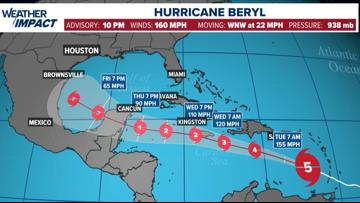- Report: Coastal flooding could threaten 1.4 million homes by midcentury
- Caught on camera | Tornado touches down in Missouri
- Carolina Hurricanes playoff tickets go on sale next week
- Storms kill 6 in the South and Midwest as forecasters warn of catastrophic rains, floods this week
- Weather Impact Alert: Cold front could trigger severe weather in Houston area this weekend | See timeline
Hurricane Beryl strengthens to Cat 5 as winds reach 160 mph

The storm strengthened into a Category 5 storm on Monday night. It’s moving to the west-northwest at 22 miles per hour.
HOUSTON — A dangerous and extremely powerful Hurricane Beryl made landfall Monday on the Caribbean island of Carriacou after becoming the earliest storm of Category 4 strength to form in the Atlantic, fueled by record-warm waters.
Then, on Monday night, it strengthened into a Category 5 storm with 160 mph winds, becoming the earliest Cat 5 storm on record.
Winds blew off roofs, uprooted trees and caused other damage on Carriacou, one of the islands of Grenada, and elsewhere in the southeast Caribbean.
“This is an extremely dangerous and life-threatening situation,” the U.S. National Hurricane Center said.
RELATED: KHOU 11 Chief Meteorologist David Paul on what Texans should be watching with Hurricane Beryl
See chief meteorologist David Paul’s (8 p.m. Monday) update on the storm here:
CURRENT LOCATION/PATH: With an update at 10 p.m. Monday, Beryl was a Category 5 storm with maximum sustained winds of 160 mph, moving west-northwest at 22 mph. (Update in Spanish).
Beryl forecast cone

In Grenada, officials received “reports of devastation” from Carriacou and surrounding islands, said Terence Walters, Grenada’s national disaster coordinator. Prime Minister Dickon Mitchell said he would travel to Carriacou as soon as it’s safe, noting that there’s been an “extensive” storm surge.
Grenada officials had to evacuate patients to a lower floor after a hospital roof was damaged, he said.
“There is the likelihood of even greater damage,” he told reporters. “We have no choice but to continue to pray.”
Beryl spaghetti models


Hurricane Season links
On Monday night, Beryl was about 510 miles (825 kilometers) east-southeast of Isla Beata, Dominican Republic, moving west-northwest at 22 mph (35 kph).
In Barbados, officials received more than a dozen reports of roof damage, fallen trees and downed electric posts across the island, said Kerry Hinds, emergency management director. Wilfred Abrahams, minister of home affairs and information, said drones — which are faster than crews fanning across the island — would assess damage once Beryl passes.
Officials in some southeast Caribbean islands announced controlled power outages and warned of water cuts ahead of the storm, as well as landslides and flash floods. Schools, airports and government offices shuttered.
Hours before the storm, Barbadian Michael Beckles said he still feared the worst for his island.
“As prepared as we can try to be, there are a lot of things that we can’t control,” he said. “There are a lot of houses that are not ready for a storm like this.”
Watches and warnings in effect
A Hurricane Warning is in effect for Jamaica and a Tropical Storm Warning is in effect for the south coast of the Dominican Republic and the south coast of Haiti.
Track the storm
Hurricane season 2024 forecast
Colorado State University released its forecast update for the 2024 hurricane season, maintaining that it will be a busy one. In April, they predicted that we could see 23 named storms and 11 hurricanes with five becoming major hurricanes. They blame the extremely warm tropical Atlantic and likely “La Niña” as the primary reasons.
RELATED: Colorado State University releases hurricane season forecast update, maintains it will be a busy one
On average, the Atlantic sees about 14 named storms each hurricane season. Of those, seven become hurricanes with three becoming major (Category 3 or above) storms.
Why such an active season? Dr. Phil Klotzbach, lead forecaster at CSU, says it’s because of two main factors — above-normal sea surface temperatures and expected La Niña conditions this summer. The warm water adds more energy to the tropics, making fuel for these storms more available. But perhaps more importantly, La Niña usually reduces vertical wind shear.
Winds blowing across a developing or mature tropical system can keep a budding system from developing and weaken stronger storms. This reduces the total storm count. But when La Niña conditions are in place, this wind shear is often reduced. That, combined with the warm ocean surface temps is why Dr. Klotzbach believes more storms than normal will form.